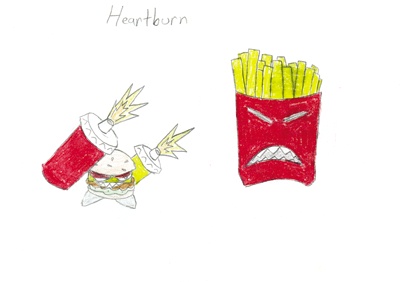All Nonfiction
- Bullying
- Books
- Academic
- Author Interviews
- Celebrity interviews
- College Articles
- College Essays
- Educator of the Year
- Heroes
- Interviews
- Memoir
- Personal Experience
- Sports
- Travel & Culture
All Opinions
- Bullying
- Current Events / Politics
- Discrimination
- Drugs / Alcohol / Smoking
- Entertainment / Celebrities
- Environment
- Love / Relationships
- Movies / Music / TV
- Pop Culture / Trends
- School / College
- Social Issues / Civics
- Spirituality / Religion
- Sports / Hobbies
All Hot Topics
- Bullying
- Community Service
- Environment
- Health
- Letters to the Editor
- Pride & Prejudice
- What Matters
- Back
Summer Guide
- Program Links
- Program Reviews
- Back
College Guide
- College Links
- College Reviews
- College Essays
- College Articles
- Back
Here’s the Beef MAG
Advertisers are, of necessity, a craftybunch. They know that almost everything we want in life is owned,controlled, or influenced by someone else. They determine which group totarget, what that group needs or thinks it wants, and then they developboth a compelling story and a delivery mechanism to capture ourimaginations - and our wallets! The teenage market is, of course, thefilet mignon on the advertiser’s menu, and one of the mostdangerous ploys in his arsenal is the direct campaign for fast food inour fast lives. It’s not as if teens are usually bombarded withcool-looking kids eating organic produce and vegetarian dishes. Thereare no rock ’n’ roll icons associated with herbal tea orantibiotic-free eggs. What we as teens should be looking for is theapparently nonhyped copy that often differentiates an organic productfrom the teeming masses of toxic food items - an increasingly difficulttask with the “in your face” fast-food mediadeluge.
Let’s look at the signs - the neon signs, I mean.Pizza Hut, with cheese everywhere you can hide it, including inside thecrust, has outlets in more than 86 countries. McDonald’s has over26,000 restaurants in 119 countries. Fast food is fast creeping intohospitals, schools, work and home. After all, who can think aboutclogged arteries and skyrocketing cholesterol when the teens in the adsare the best-looking you’ve ever seen? Hmmm ... better have morefries. If there is one thing advertisers know, it’s that if peoplecan be made sick or well by mental or visual impressions, they can beinfluenced to favor a certain brand or type of food the same way; and insome industries, like fast food, image is the best way to winthem.
Of course, this advertising extravaganza would not havetaken hold had the media gurus not been wise enough to observe the newpace of teenage life: caffeinated, insatiable, and stressed-out.It’s a daily existence obviously worthy of the billion-dollarbudget fast-food chains spend advertising to us each year. They havedevoted countless hours and dollars to learning the impulse eatinghabits of teens. We study more than ever, worry about our futures morethan ever, and have less time and inclination for dressing up to go out.Fast food allows us to date on a budget and not have a pre-set time formeals, so catching a burger on an impulse or study break becomes veryappealing. Not having to make a lot of menu decisions is also appealingto a teen overwrought with multiple-choice exams, not to mention beingable to order, wait only a few minutes and have your food served to youwithout even getting out of a car.
Our fast food advertisershave brought their “cool” food into our homes and withMTV-style production, we view it as a pop art culture - predictable andcomfortable. Remember when a grilled cheese sandwich and tomato soupwere considered comfort foods? Well, now it’s a doublecheeseburger and fries, or a four-cheese pizza and a Coke. Fast food hasbecome as American to teens as pre-washed jeans, and just as ubiquitous.And, two-thirds of fast-food restaurant employees are teenagers. Thisruthless movement in teen-media targeting has radically transformed ourdiets in the most insidiously destructive way.
The major problemwith this kind of dietary indulgence for the stressed teen is thathigh-fat products are becoming a common coping tool. Satisfyingmomentary cravings or peer pressure with an orgy of high-fat choicesleads us into a future of nutritional deficiencies, high cholesterol,and, eventually, heart problems. There is nothing cool or attractiveabout these results, and frankly, you won’t care howpopular the food is if you’re in a hospital with cloggedarteries.
Huge portion sizes, high calorie content, highamounts of refined starch and added sugar, high-fat content and lowlevels of fiber are all the ingredients one needs to destroy a youngbody. Dr. David Ludwig, director of the Obesity Program atChildren’s Hospital in Boston, noted that because of the billionsof dollars in advertising targeting a young fast-food audience eachyear, teens who frequently indulge consume approximately 187 morecalories per day. That adds up to about six extra pounds each year. Isit any wonder obesity is on the rise among young people?
Howlong will it take for our politicians to understand that legislationmight be in order to curb the appetite of media’s role infast-food promotion aimed at our nation’s teens? If we are thefuture, then they ought to care.

Similar Articles
JOIN THE DISCUSSION
This article has 7 comments.

17 articles 0 photos 14 comments
Favorite Quote:
“A man, who has no conscience, no goodness, does not suffer.”